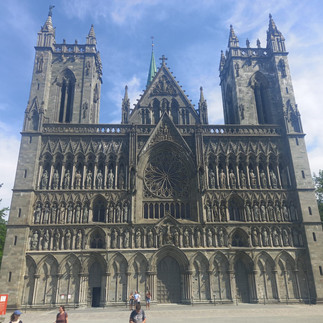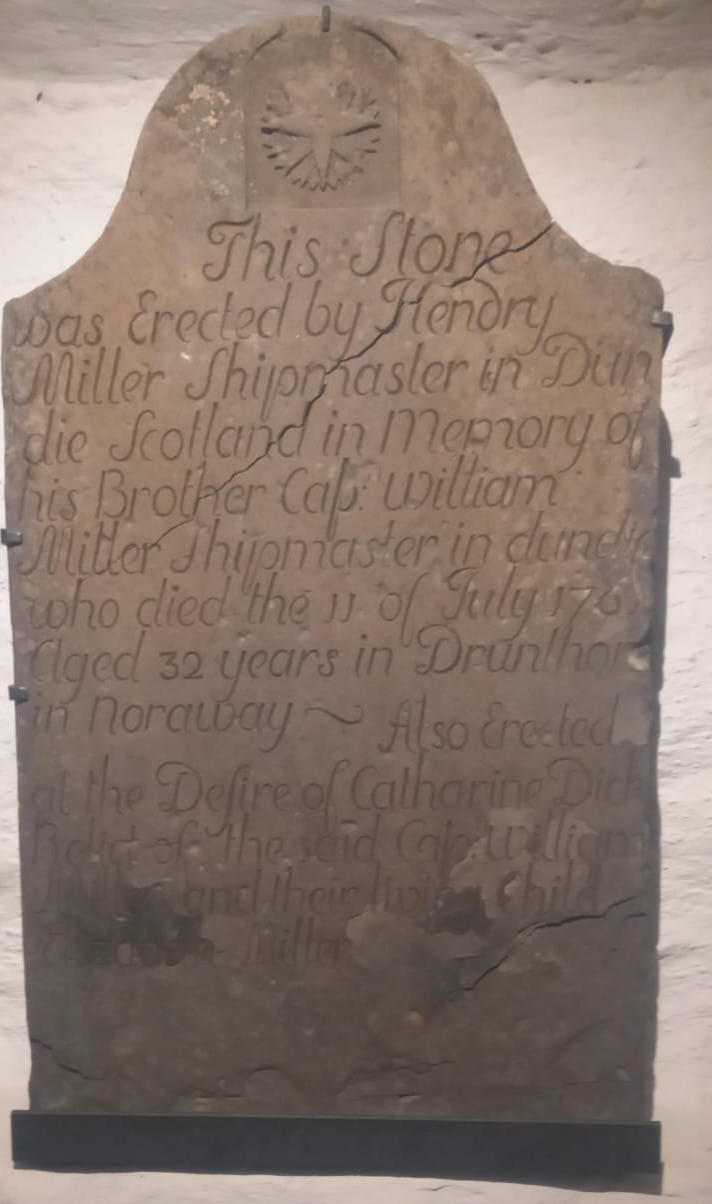Day 14 Trondheim to Mosvik ( 83 kms)
- Tim Bugler
- Jul 16, 2025
- 5 min read
The university city Trondheim, the fourth largest city in Norway with a population about that of Aberdeen is stunning, and with so much to do. Walking round the streets and canals of the town centre and the bijou Bakkandet district I was struck by how it is not just one or two houses or a couple of warehouses that one passes that are pretty as a picture -- there is street after street.
Clockwise from top left: Aboard the world's most northerly tram; street; fortress; Europe's most northerly Gothic cathedral; house; warehouses on the canal
I had just one day to sample Trondheim, so I began with a ride on the world's most northerly tram system, the Grakallbanen line, which takes one from the city centre to a terminus nearly 900 feet above sea level by a lake in an area famous for hiking, wild swimming, and outdoor recreation. Back at sea level, I visited Europe's most northerly synagogue, which opened in 1925 in a building which was formerly -- and ironically, given what was to happen later -- Trondheim's first railway station. I was the only visitor to the synagogue and was given a one-to-one guided tour. During the German occupation of Norway from 1940 to 1945 it was used as a barracks by Nazi troops. The Jews in Trondheim were arrested and sent by train to Oslo and then by ship to the concentration camps. Of 130 sent, only a handful survived, and only four or five returned to Trondheim. One family returned to re-open a famous department store they had run before the war. Another man, Robert Savosnick, son of a local watchmaker, was arrested -- by Norwegian police! -- in 1942 while working as a junior hospital doctor in Trondheim. He survived Dachau, the Warsaw ghetto, and Auschwitz (though his father didn't) and returned after the war, rising in 1975 to be the most senior consultant paediatrician at Trondheim Health Board. His story is detailed in the synagogue's small museum. He said he could never see a freight train without the horror of what happened coming back to him. Across the road from the synagogue is Nidaros Cathedral -- Europe's most northerly Gothic cathedral, built between 1070 and 1300. Stonemasons from all over Europe worked on the construction, and there is clear evidence that some of the craftsmen who carved the "corbels", or gargoyles, were the same men who carved the famous Lewis chessmen. The presence of several lewd "sheela na gig" corbels suggests English and Irish stonemasons also worked on the job. The cathedral is built over the burial site of Norway's patron saint, St Olav, in reality an ambitious Viking marauder. When he died in battle in 1030, a number of men who had been lying near him apparently dead sprang back to their feet and ran off. There are a number of explanations for this, but it began to be regarded as a miracle. A year and a day after he was buried, Olav's grave was re-opened. Instead of the smell of purification, a floral odour arose from his corpse. Hence, I speculate, the saying "coming up smelling of roses". St Olav was therefore beatified. The cathedral has two organs -- a baroque organ built in 1740 by a personal friend of Johann Sebastian Bach, and specially suited to his music, and a 1930s organ with 9600 pipes on which can be played... almost anything. The cathedral organist gave a short mini-recital when I was there, blasting out the Indiana Jones theme and ending with the music from Interstellar by Hans Zimmer, specifically written for organ. In a touch you might expect from the Norwegian Church, with its emphasis on membership of one human family, visitors who wish the congregation to pray for Intercessions may write them on slips which are offered up at the altar at the next service. Beneath the church, not really in a crypt but a cellar, are fragments of rescued gravestones, some of Norse knights, others of royalty, and to prove you can barely go anywhere in the world without bumping into a Dundonian, the gravestone of Captain William Miller, of "Dundie", who perished near Trondheim in 1765.
Gravestone of Cptn William Miller
My next plan for the day had been to give the Ven Claud a treat by introducing the old bike to "the world's first bicycle lift", designed by some Trondheim University engineering students in the 1990s to ease their way uphill to their halls of residence (one which which acts as my hostel during the summer). Sadly the "Trampe" lift (Google it!) was out of action because of construction work up the hill, so I walked up to my final destination of the day -- the Kristiansen fort, built in the late 17th century. During the war it was used by the Nazis as a place of execution for members of the Norwegian resistance. 30 Norwegian patriots were shot there, and the stumps of the execution posts to which they were tied remain as a reminder of Norway's suffering.
The number of cyclists on the EV1 is starting to build up: After my day off in Trondheim, the Ven Claud and I trundled down to the town pier to catch the ferry across the fjord where the route continues, only to find the next sailing cancelled due to a technical issue with the boat and doubt hanging over the sailing after that. We got as far as boarding for the next sailing, but after 20 minutes and some ineffectual rumblins were told to get off again for a “bus for boat” replacement service. My experience of bus replacements on Britain's railways is that they often refuse to countenance loading a bike, leaving cyclists completely in the lurch, but not so here – at least eight bikes were loaded into the undercarriage of the coach, which then took us across the 10 kilometre-wide fjord via a ferry from a more distant quay, before delivering us to the little settlement of Vanvikan, where we were off-loaded. A 25 minute crossing had taken three and a quarter hours, much to everyone's frustration, but biking friendships and alliances are made of stuff like this, and I set off in the pleasant company of Chantelle, Tina, Eddie and Christophe, all from Belgium and all hoping to make it to Nordkapp, having also had a chat with several cyclists from Germany who I expect I'll see again on the way. Near the village of Leksvik the Belgians decided to stop for the night at a very pleasant spot by the fjord, but I felt I hadn't done enough kilometres, and I also knew there was a monster of a climb ahead that I didn't want to leave till the next day so I carrried on. I ended up camped in a clearing in a forest by a peaceful stream, marred only by the predations of mosquitos, midges and cleggs that combined to oblige me to retire early to my bug-proof nylon sanctuary.
















Enjoying the blogs hugely Tim but worried you are a bit solo. Alone on the Trondheim tram and when you meet four nice Belgians, you leave them to live amongst the midges.
You make Trondheim enticing and we will go there as soon as Norway promises to stop whaling. God knows oed where this underlining has come from. There is enough stress in life as it is. Jerry